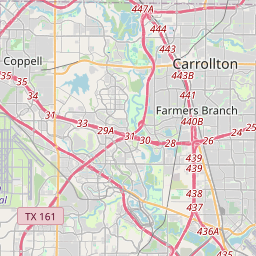Bill and Maude Dodson House
Historical marker location:






This historic Farmers Branch residence was the home of the city's first mayor. William F. (Bill) Dodson (1895-1949), a native of Malakoff, married Maude Gilmore (1896-1998) in Fort Worth in July 1917. The following May, Bill became a private in the 36th Infantry Division, serving in France's Meuse-Argonne sector during the First World War The Dodsons'son Smith was born in November 1918. After the war, the Dodson family lived in Dallas and became active in real estate and oil. They moved to Farmers Branch in the 1930s and commissioned contractor Ross Faulkner to design a house to Maude's specifications. Completed by 1937, it was originally closer to Farmers Branch Creek but moved to its present site in 1942. In January 1946, Bill Dodson learned the city of Dallas, with city limits then 12 miles distant, planned to annex the Farmers Branch community. He and his neighbors circulated a petition for a local incorporation election. Citizens voted approval, and in April they elected Dodson the first mayor. H.O. Good, Lawson Lewis, Raymond Milloway, Thomas Reeder and Glenn Templin became the first aldermen. The new city council held three meetings in the Dodson House, with others conducted at Mason Lodge No. 395, where Dodson was a member. During his two-year term as mayor, Farmers Branch hired its first city employees, established a fire department and water system, and joined the League of Texas Municipalities. Maude stayed in the house until 1983, donating it to the city as the core of a heritage park. The Colonial Revival one-story frame house has telescoping wings, side gables, wood siding, six-over-one windows and a slender pedimented entry with square columns. Recorded Texas Historic Landmark – 2007 Marker is property of the state of Texas
As one of the most visible programs of the Texas Historical Commission (THC), historical markers commemorate diverse topics in Texas history, including: the history and architecture of houses, commercial and public buildings, religious congregations, and military sites; events that changed the course of local and state history; and individuals who have made lasting contributions to the state, community organizations, and businesses.
The city of Austin, the state capital, is known as the live music capital of the world. It is home to many music festivals, including South by Southwest (SXSW) and the Austin City Limits Music Festival.
Established in 1846, Dallas County played a crucial role in the development of North Texas. The county's namesake, George Mifflin Dallas, was the Vice President of the United States at the time. The city of Dallas, the county seat, quickly emerged as a center for trade and commerce due to its strategic location along major transportation routes.
During the late 19th century, Dallas County experienced rapid economic growth driven by industries such as cotton, railroads, and cattle. The city of Dallas became a major hub for cotton trading, attracting business and establishing itself as a prominent financial center in the Southwest.
In the 20th century, Dallas County continued to evolve and diversify its economy. The discovery of oil in the nearby East Texas Oil Field in the early 1900s led to the development of the oil industry in the region, contributing to the county's prosperity. The county also played a significant role in the aerospace industry, hosting the headquarters of major aerospace companies and contributing to the growth of aviation technology.
Dallas County's cultural landscape reflects its vibrant and diverse population. The county is home to a wide range of cultural institutions, including museums, art galleries, theaters, and music venues. Dallas County also played a notable role in the civil rights movement, with important milestones in the fight for equality and integration.
Today, Dallas County stands as a major economic and cultural center. It boasts a robust economy supported by various industries, including finance, technology, healthcare, and telecommunications. The county is known for its thriving arts scene, professional sports teams, and diverse culinary offerings.
With its rich history, economic vitality, and cultural significance, Dallas County continues to shape North Texas as a dynamic and influential region.
Dallas County Timeline
This timeline provides a condensed summary of the historical journey of Dallas County, Texas.
Pre-19th Century: The area was originally inhabited by various indigenous tribes, including the Caddo, Wichita, and Comanche.
1839: Dallas County was officially established and named after George Mifflin Dallas, the Vice President of the United States under President James K. Polk.
Mid-19th Century: Dallas County experienced significant growth with the establishment of Dallas as a trading post and the arrival of settlers drawn by the opportunities in trade and agriculture.
Late 1800s: The county prospered with the expansion of railroads, particularly the Texas and Pacific Railway and the Houston and Texas Central Railroad, which solidified Dallas as a major transportation hub.
Early 20th Century: Dallas County saw a surge in economic development and urbanization. Industries such as oil, cotton, banking, and manufacturing fueled the city's growth.
1960s: Dallas County gained national attention due to its role in the civil rights movement. The city of Dallas was the site of the assassination of President John F. Kennedy in 1963.
Late 20th Century: Dallas County continued to experience rapid growth and diversification, becoming a major center for business, finance, and telecommunications. The county is known for its vibrant arts and cultural scene, including the Dallas Arts District.
Today, Dallas County is the second-most populous county in Texas and home to the city of Dallas, a thriving metropolitan area.